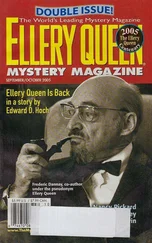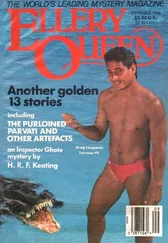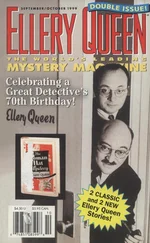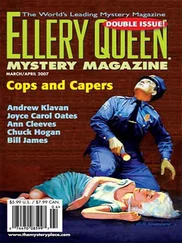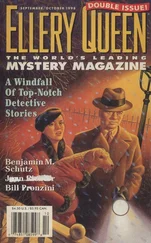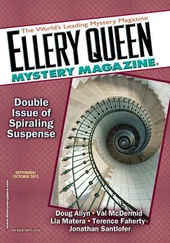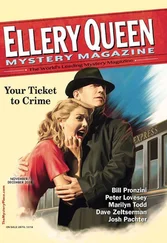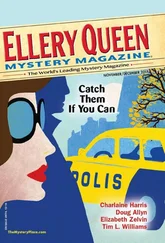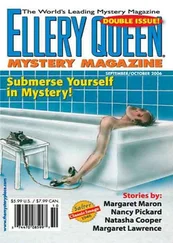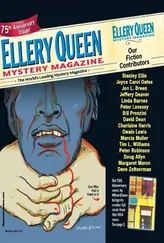William Bankier - Ellery Queen’s Mystery Magazine, Vol. 110, No. 3 & 4. Whole No. 673 & 674, September/October 1997
Здесь есть возможность читать онлайн «William Bankier - Ellery Queen’s Mystery Magazine, Vol. 110, No. 3 & 4. Whole No. 673 & 674, September/October 1997» весь текст электронной книги совершенно бесплатно (целиком полную версию без сокращений). В некоторых случаях можно слушать аудио, скачать через торрент в формате fb2 и присутствует краткое содержание. Город: New York, Год выпуска: 1997, Издательство: Dell Magazines, Жанр: Детектив, на английском языке. Описание произведения, (предисловие) а так же отзывы посетителей доступны на портале библиотеки ЛибКат.
- Название:Ellery Queen’s Mystery Magazine, Vol. 110, No. 3 & 4. Whole No. 673 & 674, September/October 1997
- Автор:
- Издательство:Dell Magazines
- Жанр:
- Год:1997
- Город:New York
- ISBN:нет данных
- Рейтинг книги:4 / 5. Голосов: 1
-
Избранное:Добавить в избранное
- Отзывы:
-
Ваша оценка:
- 80
- 1
- 2
- 3
- 4
- 5
Ellery Queen’s Mystery Magazine, Vol. 110, No. 3 & 4. Whole No. 673 & 674, September/October 1997: краткое содержание, описание и аннотация
Предлагаем к чтению аннотацию, описание, краткое содержание или предисловие (зависит от того, что написал сам автор книги «Ellery Queen’s Mystery Magazine, Vol. 110, No. 3 & 4. Whole No. 673 & 674, September/October 1997»). Если вы не нашли необходимую информацию о книге — напишите в комментариях, мы постараемся отыскать её.
Ellery Queen’s Mystery Magazine, Vol. 110, No. 3 & 4. Whole No. 673 & 674, September/October 1997 — читать онлайн бесплатно полную книгу (весь текст) целиком
Ниже представлен текст книги, разбитый по страницам. Система сохранения места последней прочитанной страницы, позволяет с удобством читать онлайн бесплатно книгу «Ellery Queen’s Mystery Magazine, Vol. 110, No. 3 & 4. Whole No. 673 & 674, September/October 1997», без необходимости каждый раз заново искать на чём Вы остановились. Поставьте закладку, и сможете в любой момент перейти на страницу, на которой закончили чтение.
Интервал:
Закладка:
There was no crime, because nothing was missing from the quarterly inventory. First, I would photograph the work. Indeed, on a couple of occasions I even took one of Jance’s young artists down to the storerooms and showed her the painting she’d be copying. She’d been chosen because she had studied the minimalists, and this was to be a minimalist commission.
Minimalism, interestingly, proved the most difficult style to reproduce faithfully. In a busy picture, there’s so much to look at that one can miss a wrong shade or the fingers of a hand which have failed to curl to the right degree. But with a couple of black lines and some pink waves... well, fakes were easier to spot. So it was that Jance’s artist saw the work she was to replicate face-to-face. Then we did the measurements, took the Polaroids, and she drew some preliminary sketches. Jance was in charge of finding the right quality of canvas, the correct frame. My job was to remove the real canvas, smuggle it from the gallery, and replace it with the copy, reframing the finished work afterwards.
We were judicious, Jance and I. We chose our works with care. One or two a year — we never got greedy. The choice would depend on a combination of factors. We didn’t want artists who were too well known, but we wanted them dead if possible. (I had a fear of an artist coming to inspect his work at the Tate and finding a copy instead.) There had to be a buyer — a private collector — who would keep the work private. We couldn’t have a painting being loaned to some collection or exhibition when it was supposed to be safely tucked away in the vaults of the Tate. Thankfully, as I’d expected, Jance seemed to know his market. We never had any problems on that score. But there was another factor. Every now and then there would be requests from exhibitions for the loan of a painting — one we’d copied. But as the curator, I would find reasons why the work in question had to remain at the Tate, and might offer, by way of consolation, some other work instead.
Then there was the matter of rotation. Now and again — as had to be the case, or suspicion might grow — one of the copies would have to grace the walls of the gallery proper. Those were worrying times, and I was careful to position the works in the least flattering, most shadowy locations, usually with a much more interesting picture nearby, to lure the spectator away. I would watch the browsers. Once or twice, an art student would come along and sketch the copied work. No one ever showed a moment’s doubt, and my confidence grew.
But then... then...
We had loaned works out before, of course — I’d told the dinner party as much. This or that cabinet minister might want something for the office, something to impress visitors. There would be discussions about a suitable work. It was the same with particular benefactors. They could be loaned a painting for weeks or even months. But I was always careful to steer prospective borrowers away from the twenty or so copies. It wasn’t as though there was any lack of choice! For each copy, there were fifty other paintings they could have. The odds, as Jance had assured me more than once, were distinctly in our favour.
Until the day the prime minister came to call.
This is a man who knows as much about art as I do home brewing. There is almost a glee about his studious ignorance — and not merely of art. But he was walking around the Tate, for all the world like a dowager around a department store, and not seeing what he wanted.
“Voore,” he said at last. I thought I’d misheard him. “Ronny Voore. I thought you had a couple.”
My eyes took in his entourage, not one of whom would know a Ronny Voore if it blackballed them at the Garrick. But my superior was there, nodding slightly, so I nodded with him.
“They’re not out at the moment,” I told the PM.
“You mean they’re in?” He smiled, provoking a few fawning laughs.
“In storage,” I explained, trying out my own smile.
“I’d like one for Number Ten.”
I tried to form some argument — they were being cleaned, restored, loaned to Philadelphia — but my superior was nodding again. And after all, what did the PM know about art? Besides, only one of our Voores was a fake.
“Certainly, Prime Minister. I’ll arrange for it to be sent over.”
“Which one?”
I licked my lips. “Did you have one in mind?”
He considered, lips puckered. “Maybe I should just have a little look...”
Normally, there were no visitors to the storerooms. But that morning, there were a dozen of us posed in front of the two Ronny Voores, Shrew Reclining and Herbert in Motion. Voore was very good with titles. I’ll swear, if you look at them long enough, you really can see — beyond the gobbets of oil, the pasted-on photographs and cinema stubs, the splash of emulsion and explosion of colour — the figures of a large murine creature and a man running.
The prime minister gazed at them in something short of thrall. “Is it ‘shrew’ as in Shakespeare?”
“No, sir, I think it’s the rodent.”
He thought about this. “Vibrant colours,” he decided.
“Extraordinary,” my superior agreed.
“One can’t help feeling the influence of pop art,” one of the minions drawled. I managed not to choke; it was like saying one could see in Beryl Cook the influence of Picasso.
The PM turned to the senior minion. “I don’t know, Charles. What do you think?”
“The shrew, I think.”
My heart leapt. The prime minister nodded, then pointed to Herbert in Motion. “That one, I think.”
Charles looked put out, while those around him tried to hide smiles. It was a calculated put-down, a piece of politics on the PM’s part. Politics had decided: A fake Ronny Voore would grace the walls of Number 10 Downing Street.
I supervised the packing and transportation. It was a busy week for me: I was negotiating the loan of several Rothkos for an exhibition of early works. Faxes and insurance appraisals were flying. American institutions were very touchy about lending stuff. I’d had to promise a Braque to one museum — and for three months at that — in exchange for one of Rothko’s less inspired creations. Anyway, despite headaches, when the Voore went to its new home, I went with it.
I’d discussed the loan with Jance. He’d told me to switch the copy for some other painting, insisting that “no one would know.”
“He’ll know,” I’d said. “He wanted a Voore. He knew what he wanted.”
“But why?”
Good question, and I’d yet to find the answer. I’d hoped for a first-floor landing, or some nook or cranny out of the general view, but the staff seemed to know exactly where the painting was to hang — something else had been removed so that it could take pride of place in the dining room. (Or one of the dining rooms; I couldn’t be sure how many there were. I’d thought I’d be entering a house, but Number 10 was a warren, a veritable Tardis, with more passageways and offices than I could count.)
I was asked if I wanted a tour of the premises, so as to view the other works of art, but by that time my head really did ache, and I decided to walk back to the Tate, making it as far as Millbank before I had to rest beside the river, staring down at its sludgy flow. The question had yet to be answered: Why did the PM want a Ronny Voore? Who in their right mind wanted a Voore these days?
The answer, of course, came with the telephone call.
Joe Hefferwhite was an important man. He had been a senator at one time. He was now regarded as a “senior statesman,” and the American president sent him on the occasional high-profile, high-publicity spot of troubleshooting and conscience-salving. At one point in his life, he’d been mooted for president himself, but of course his personal history had counted against him. In younger days, Hefferwhite had been a bohemian. He’d spent time in Paris, trying to be a poet. He’d walked a railway line with Jack Kerouac and Neal Cassady. Then he’d come into enough money to buy his way into politics and had prospered there.
Читать дальшеИнтервал:
Закладка:
Похожие книги на «Ellery Queen’s Mystery Magazine, Vol. 110, No. 3 & 4. Whole No. 673 & 674, September/October 1997»
Представляем Вашему вниманию похожие книги на «Ellery Queen’s Mystery Magazine, Vol. 110, No. 3 & 4. Whole No. 673 & 674, September/October 1997» списком для выбора. Мы отобрали схожую по названию и смыслу литературу в надежде предоставить читателям больше вариантов отыскать новые, интересные, ещё непрочитанные произведения.
Обсуждение, отзывы о книге «Ellery Queen’s Mystery Magazine, Vol. 110, No. 3 & 4. Whole No. 673 & 674, September/October 1997» и просто собственные мнения читателей. Оставьте ваши комментарии, напишите, что Вы думаете о произведении, его смысле или главных героях. Укажите что конкретно понравилось, а что нет, и почему Вы так считаете.

